- Home
- About
- Map
- Trips
- Bringing Boat West
- Migration West
- Solo Motorcycle Ride
- Final Family XC Trip
- Colorado Rockies
- Graduates' XC Trip
- Yosemite & Nevada
- Colorado & Utah
- Best of Utah
- Southern Loop
- Pacific Northwest
- Northern Loop
- Los Angeles to NYC
- East Coast Trips
- Martha's Vineyard
- 1 Week in Quebec
- Southeast Coast
- NH Backpacking
- Martha's Vineyard
- Canadian Maritimes
- Ocracoke Island
- Edisto Island
- First Landing '02
- Hunting Island '02
- Stowe in Winter
- Hunting Island '01
- Lake Placid
- Chesapeake
- Provincetown
- Hunting Island '00
- Acadia in Winter
- Boston Suburbs
- Niagara Falls
- First Landing '99
- Cape Hatteras
- West Coast Trips
- Burning Man
- Utah Off-Roading
- Maui
- Mojave 4WD Course
- Colorado River Rafting
- Bishop & Death Valley
- Kauai
- Yosemite Fall
- Utah Off-Road
- Lost Coast
- Yosemite Valley
- Arizona and New Mexico
- Pescadero & Capitola
- Bishop & Death Valley
- San Diego, Anza Borrego, Joshua Tree
- Carmel
- Death Valley in Fall
- Yosemite in the Fall
- Pacific Northwest
- Utah Off-Roading
- Southern CA Deserts
- Yosemite & Covid
- Lake Powell Covid
- Eastern Sierra & Covid
- Bishop & Death Valley
- Central & SE Oregon
- Mojave Road
- Eastern Sierra
- Trinity Alps
- Tuolumne Meadows
- Lake Powell Boating
- Eastern Sierra
- Yosemite Winter
- Hawaii
- 4WD Eastern Sierra
- 4WD Death Valley +
- Southern CA Deserts
- Christmas in Tahoe
- Yosemite & Pinnacles
- Totality
- Yosemite & Sierra
- Yosemite Christmas
- Yosemite, San Diego
- Yosemite & North CA
- Seattle to Sierra
- Southwest Deserts
- Yosemite & Sierra
- Pacific Northwest
- Yosemite & South CA
- Pacific Northwest
- Northern California
- Southern Alaska
- Vancouver Island
- International Trips
- Index
- Tips
- Books
- Photos/Videos
- Search
- Contact
Sukhothai, Thailand
Monday, March 19, 2018 - 9:45am by Lolo
225 miles and 5 hours from our last stop - 1 night stay
Travelogue
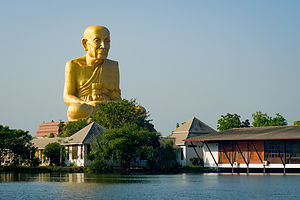 Golden monkWe would have lots of time on the bus today, as the drive from Ayutthaya north to Sukhothai is 225 miles. No worries about being bored though. There was no downtime with Udom. For the entire drive he stood at the front of the bus with his microphone and spoke to us about what we had seen and what we would see at the next stop, as well answering any questions we had about pretty much anything - ranging from his personal relationship to Buddhism, his feelings about the monarchy and the current and previous king, how the Thai people are adjusting to the transition into a developed and modernized nation, and whatever else we could think of. He was extremely open and honest with his answers. This is the kind of insight into the culture of Thailand that we could never have gotten if we had done this trip on our own.
Golden monkWe would have lots of time on the bus today, as the drive from Ayutthaya north to Sukhothai is 225 miles. No worries about being bored though. There was no downtime with Udom. For the entire drive he stood at the front of the bus with his microphone and spoke to us about what we had seen and what we would see at the next stop, as well answering any questions we had about pretty much anything - ranging from his personal relationship to Buddhism, his feelings about the monarchy and the current and previous king, how the Thai people are adjusting to the transition into a developed and modernized nation, and whatever else we could think of. He was extremely open and honest with his answers. This is the kind of insight into the culture of Thailand that we could never have gotten if we had done this trip on our own.
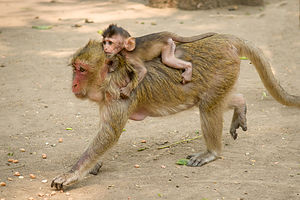 Mama macaque monkey and her young We weren’t even on the road a half hour, before we took a brief stop just a short distance off the highway to see a giant golden monk, larger than a 4-story building, sitting in the meditative lotus position on the other side of the pond from an outdoor market. Udom joked that he pulled in here, because if he didn’t one of us would be sure to say, “Why aren’t we seeing that?” You couldn’t exactly sneak past it.
Mama macaque monkey and her young We weren’t even on the road a half hour, before we took a brief stop just a short distance off the highway to see a giant golden monk, larger than a 4-story building, sitting in the meditative lotus position on the other side of the pond from an outdoor market. Udom joked that he pulled in here, because if he didn’t one of us would be sure to say, “Why aren’t we seeing that?” You couldn’t exactly sneak past it.
Udom was extremely accommodating in meeting any of our requests or needs. His motto was, “You’re the boss. I work for you.” So, when someone in our group merely mentioned their interest in monkeys, he added a spontaneous stop along the way at Khao No-Khao Kaeo, a Wat at the foot of a limestone mountain where monkeys like to hang out.
When getting our travel shots at Kaiser before the trip, the travel nurse warned us to stay away from the monkeys in Thailand, as they are very aggressive and carry diseases. Now here we were intentionally seeking them out. Udom was not about to lose one of his charges, so he gave us strict instructions to not go near them and to allow he or one of the workers do any feeding.
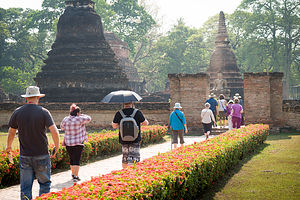 Gate1 approaches Sukhothai Historical ParkIt was hard to believe that something so adorable could be so dangerous. These were macaque monkeys, and they were about two feet tall and weighed less than 15 pounds. Many of them had suckling babies hanging onto their bellies while others were carrying babies on their backs. What a spontaneous and fun stop!
Gate1 approaches Sukhothai Historical ParkIt was hard to believe that something so adorable could be so dangerous. These were macaque monkeys, and they were about two feet tall and weighed less than 15 pounds. Many of them had suckling babies hanging onto their bellies while others were carrying babies on their backs. What a spontaneous and fun stop!
Then it was on to the main event of the day, the Sukhothai Historical Park, which like Ayutthaya is a UNESCO World Heritage Site.
Again, I think some general background information about the significance of this site to Thailand’s history would be helpful. Let’s just say that Sukhothai is the “Once upon a time…” part of Thailand’s history.
Before its rise, Siam was made up of small fiefdoms, subject to the ancient Khmer Empire’s rule. In 1238, two Thai rulers, Pho Khun Pha Muang and Pho Khun Bang Lang Hao, were able to consolidate power and succeed the Khmer as the rulers of the newfound kingdom of Siam. Sukhothai, which means “Dawn of Happiness,” became its first capital.
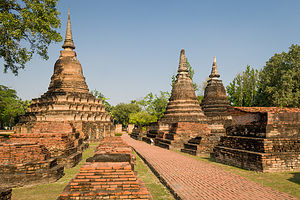 Sukhothai Historical Park - Wat MahathatDespite it short lifespan (1238 to 1438), the Sukhothai Kingdom marked a golden period for religion, art, and architecture in Thailand. King Ramkhamhaeng the Great, the second ruling monarch of the newly established kingdom, established Theravada Buddhism as the state religion and he is also credited with the creation of the Thai alphabet.
Sukhothai Historical Park - Wat MahathatDespite it short lifespan (1238 to 1438), the Sukhothai Kingdom marked a golden period for religion, art, and architecture in Thailand. King Ramkhamhaeng the Great, the second ruling monarch of the newly established kingdom, established Theravada Buddhism as the state religion and he is also credited with the creation of the Thai alphabet.
From about 1378 onwards, Sukhothai slowly entered a period of decline. By 1438 it was fully annexed by the Ayutthaya Kingdom, whose ruins we had visited yesterday. Gate1 was taking us on a trip back in time.
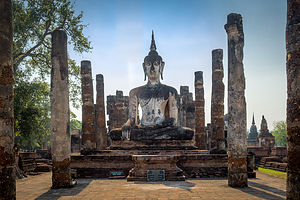 Sukhothai Historical Park - Wat MahathatOur visit to the Sukhothai Historical Park began in Wat Mahathat, which confused me a bit, because that was also the name of the Wat we visited in Ayutthaya. However, the architectural styles between the two capitals differed a bit.
Sukhothai Historical Park - Wat MahathatOur visit to the Sukhothai Historical Park began in Wat Mahathat, which confused me a bit, because that was also the name of the Wat we visited in Ayutthaya. However, the architectural styles between the two capitals differed a bit.
In addition to building Khmer-style, corn-shaped prangs, as in Ayutthaya, Sukhothai temple craftsmen also developed their own style, known as the “Sukhothai style,” the most notable feature being one central lotus-bud chedi, surrounded by smaller bell-shaped chedis. If you recall from our first Wat visit in Bangkok, a chedi (or stupa) is a structure used to house relics, such as the remains of Buddhist monks or nuns.
Another notable feature of the “Sukhothai style” are its graceful depictions of the Buddha, several of which had feminine characteristics.
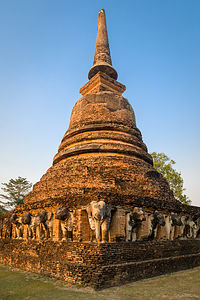 Wat Chang Lom behind hotelThe Buddhas in this complex seemed particularly peaceful and serene. I’m not sure what materials they were made from, but their current white with black coloring made them stand out in contrast to the darker reddish browns of the structures.
Wat Chang Lom behind hotelThe Buddhas in this complex seemed particularly peaceful and serene. I’m not sure what materials they were made from, but their current white with black coloring made them stand out in contrast to the darker reddish browns of the structures.
The most famous and photographed image in Sukhothai is that of a giant Buddha, seated in the lotus position behind rows of half-collapsed columns. Although no longer serving a functional purpose, these columns have assumed an aesthetic role. I liked the way the verticality of the columns mimicked the sharp pointy top on the Buddha’s head.
Right on schedule, Udom herded us back onto the bus, which brought us to our home for the night, the Legendha Sukhothai.
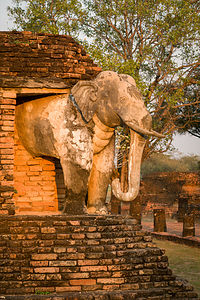 Wat Chang Lom behind hotelThis was my favorite hotel so far. While definitely less luxurious than the ones in Bangkok and Ayutthaya, where it felt like you could be anywhere, the ambience of this one was much more authentic Thai. We really felt like we were sleeping in Thailand for the first time - even if the toilet leaked a bit and the bed was hard. Our towels were even folded into the shape of an elephant. I almost didn’t want to shower and ruin them.
Wat Chang Lom behind hotelThis was my favorite hotel so far. While definitely less luxurious than the ones in Bangkok and Ayutthaya, where it felt like you could be anywhere, the ambience of this one was much more authentic Thai. We really felt like we were sleeping in Thailand for the first time - even if the toilet leaked a bit and the bed was hard. Our towels were even folded into the shape of an elephant. I almost didn’t want to shower and ruin them.
When checking in, Udom happened to mention that there was another temple ruin, a short walk behind our hotel. He wasn’t kidding! What a treasure in our own backyard, and one we had totally to ourselves to enjoy during the magical sunset hour.
The small temple complex was called Wat Chang Lom, the “Elephant Circled Monastery,” and it consisted of a main bell-shaped chedi (to hold relics), in the Sukhothai style, with 36 elephants sculpted into its base. It was amazing that a majority of those elephants, including their delicate trunks, were still intact. It was our very favorite ruin of all! So peaceful to just wander through.
We concluded our busy day with a dip in the hotel pool. I had made it my personal goal to do so at every hotel we stayed at, an easy and pleasant task considering how hot and humid it was.
- ‹ previous
- 3 of 7
- next ›
Sukhothai location map in "high definition"
Javascript is required to view this map.
